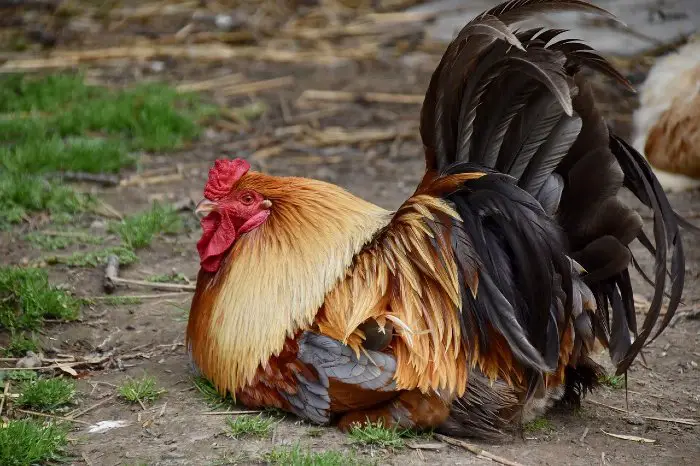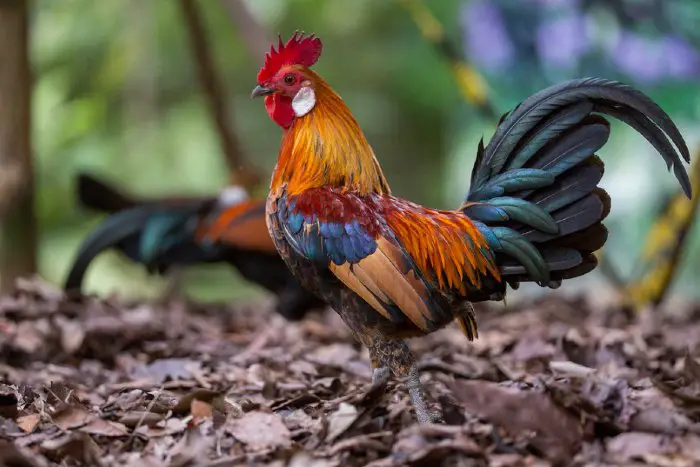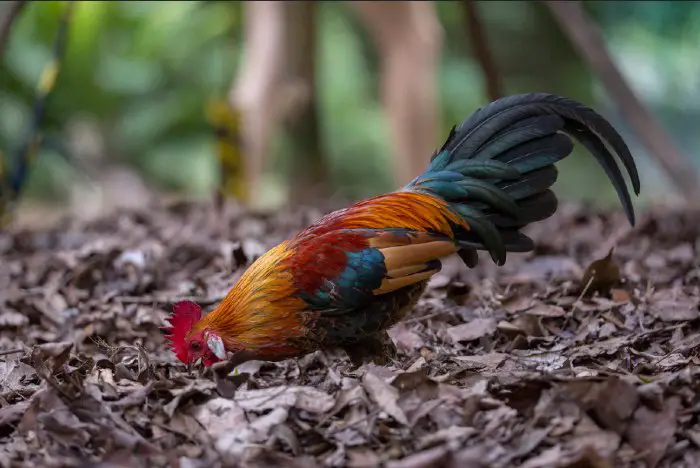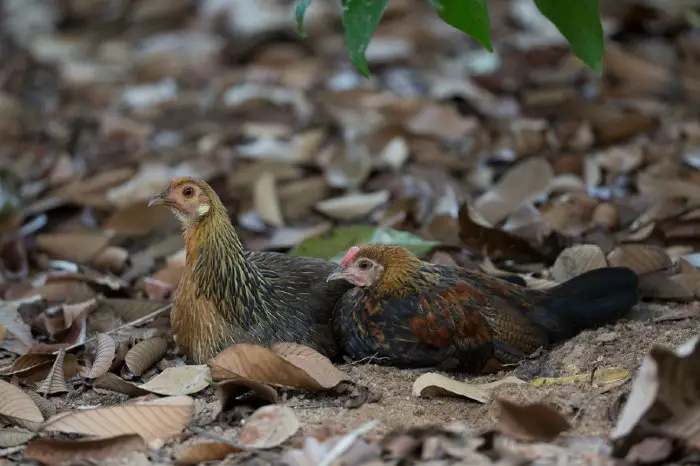As you may well know, modern chickens have never really lived in the wild. It is a purely domestic breed. Any chickens that can actually be found in the world will have descended from domestic chickens. Of course, the original chickens had to come from somewhere, right? So, where do chickens come from? They come from the Red Junglefowl.

The Red Junglefowl is a chicken that you can still find in the wild today, although you may also find that some people own the Red or Green Junglefowl.
But it is not really a productive bird, so this is probably just for the thrill of raising a unique bird as opposed to anything else.
On this page, we want to cover as much as we can about the Red Junglefowl as possible. This should, hopefully, teach you a little bit about how it came to become the chicken we all know and love today.
Where Do Chickens Come From? – The Origin of the Red Jungle Fowl
The Red Junglefowl is considered as the primary ancestor of the domestic chicken.
Most people just assume that the Red Junglefowl is how we ended up with domesticated chickens, and it is 100% certain that the Red Junglefowl had most of the input into the domestication, there is a strong chance that other Junglefowl may have been brought into the chicken mix at some point.
The Red Junglefowl first appeared around 23-million years ago. It is a species of bird that evolved from the pheasant. Of course, it was a rather slow process, and the full split from the pheasant didn’t occur until around 6-million years ago.

However, at this stage, it is pretty tough to tell exactly what happened as this happened so many years ago.
Although let’s be fair, this means that the bird has been around longer than humans have been! It is worth noting at this point that the Red Junglefowl is one of several different types of Junglefowl.
The Look of the Red Jungle Fowl
Despite the name of the bird, it is not strictly a bird that can only be red. It comes in a variety of different colors, and this color can change throughout the year as the chicken molts.
To be honest, the overall look of the Red Junglefowl isn’t that much different to that of a domestic chicken.
Although, the hens do have a lot less plumage than the roosters.
The main difference is the size of the bird. The Red Junglefowl will cap out at about 2.25 lbs (1 kg) in size for the hens, and 3.25 lbs (1.5 kg) in size for the roosters.
This is, of course, much closer to the size of a bantam chicken than your typical chicken breeds.

Where Does the Red Junglefowl Live?
The Red Junglefowl can be found throughout Southeast Asia. It is mostly in the wild, but there are some families that keep the Red Junglefowl as a pet in these countries.
When it is kept as a pet, it is slightly more productive than the wild counterparts, but not drastically so. If you want a productive bird, then it will almost certainly be the chicken that you want.
The Domestication of the Red Junglefowl
When we talk about the ‘domestication’ of this bird, we are talking about how the Red Junglefowl gradually became a domestic creature i.e. the chicken. Do bear in mind that chickens and Red Junglefowl are related still. One is just the domesticated form of it i.e. the bird that has been designed to be raised by humans.

We have very little information available about how the Red Junglefowl became a domesticated bird. Evidence suggests that the process happened at least 8,000 years ago.
However, it is highly likely that there were attempts to domesticate the bird a long time before that. As you can likely imagine, the domestication of an animal is never, ever going to be a simple process!
According to research, the birds that were originally domesticated all came from roughly the same area. So there is a good chance that the initial domestication was pretty much a solo process.
However, once they were domesticated, things started to happen rather quickly, and the chicken had spread throughout Asia and into Europe over the next few thousand years.
It is unknown how the chicken did spread so rapidly, but since people were highly mobile 8,000 years ago, it is likely that they carried it from country to country. This certainly explains how the bird actually spread.
The fact it traveled from the East into the West slowly shows that it was likely brought across the land by nomads.
One thing that has been somewhat confusing for researchers is how other types of Junglefowl were able to get into the chicken’s gene pool. It is believed that about 75% of the initial genes of a chicken come from the Red Junglefowl.
However, researchers believe that the Grey Junglefowl also likely played a role. You would think that this wouldn’t be confusing, but, oddly enough, the Grey Junglefowl cannot mate with the Red Junglefowl. Research is still going on as to how this may have happened.
Similarities with the Domestic Chicken
If you look at the way that the Red Junglefowl behaves, you will likely notice that there is a lot of overlap between their behavior and that of the domestic chicken. They forage in much the same way. They attract mates in much the same way and they roost in the same way.
In fact, if you didn’t know what a Red Junglefowl actually looked like, you would mistake it for a chicken. They are that similar.

Red Junglefowl Breeding
This is where we actually see some differences between the Junglefowl and the domestic chicken. Obviously, one of the main products from a chicken would be an egg, yes? This means that you want the chicken to be laying eggs fairly frequently.
The problem with the Red Junglefowl is that it is not that consistent with its eggs. There are some parts of the year where it will lay eggs regularly (this will normally be during the dryest parts of the year), and other times where it will not lay anything.
You also have to consider the fact that, in the wild, food is not going to be as consistent when in a domestic environment. This means that the Red Junglefowl doesn’t really have the nutrients that it needs in order to produce eggs.
It is estimated that a wild Red Junglefowl can produce somewhere between 15 and 30 eggs per year, while ones kept in captivity can produce ever so slightly more than this due to the increased food intake.
It is likely that domestication took place because the people who tried to domesticate the Red Junglefowl were looking for ways in which they could get it to produce more eggs fairly regularly.
The Red Junglefowl as an Egg-laying Bird
Obviously, the 30-eggs per year is a stark contrast to the domesticated chicken that produces at least 150 in most cases. So, we can say that chicken breeders have been a success on this front!
Red Junglefowl takes a lot longer to reach sexual maturity in comparison to domesticated chickens too. They will not start laying eggs until they are at least 5-months old.
This can make them tough to breed. So, once again, this is likely a trait that those who domesticated them wanted to improve.
Once they have produced offspring, they tend not to keep them around that long either. Within a few weeks of the chicks hatching, they are thrust out into the open world with the expectation that they will roam around on their own and mate elsewhere.
This, of course, is not really something that you will see in the domestic chicken.
Meet Production
While this bird is only really used for meat purposes in some parts of the world, we do want to draw attention to the meat of the Red Junglefowl.
This bird is tiny. Far smaller than your average domestic chicken. This means that it doesn’t actually produce a lot of meat.
Of course, it is likely that one of the goals of those that domesticated it was to create a bird that produced a lot more meat and, of course, this ultimately happened.
Read more about the best meat chicken breeds.
As we said; there are still people that eat the Red Junglefowl today, but if you look at the spread of this bird, you will actually find that the numbers are dwindling.
This is because more and more people are moving onto the chicken, simply because the chicken is easier to raise. After all, the chicken was explicitly designed to be raised in an environment like this!
Conclusion
While it is not important to know the history of the Red Junglefowl if you want to raise your own chickens, we thought you would enjoy learning the history of how and where the domestic chicken came to be.
You also may likely enjoy the fact that the original bird is still out there. Feeding the same groups of people that it did thousands and thousands of years ago.
Remember; no matter what breed of chicken you actually have, there will always be a small amount of Red Junglefowl in it. This incredibly exciting!
